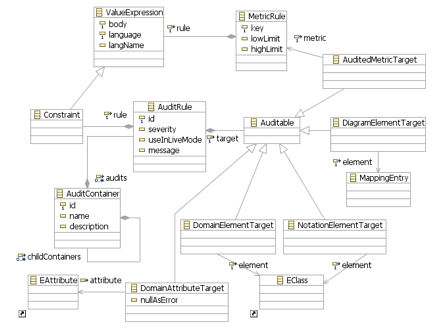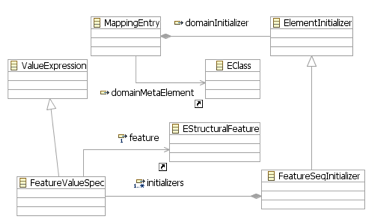- 浏览: 170061 次
- 性别:

- 来自: 杭州
-

文章分类
最新评论
-
Vcb:
http://osgi.jxtech.net 是目前发现最好的 ...
OSGi控制台在Eclipse插件开发中的妙用 -
zxjlwt:
学习了。http://surenpi.com
OSGi控制台在Eclipse插件开发中的妙用 -
enen1982:
这个写得相当不错,找了好久,省了我一堆事,能不能复制整个目录
Eclipse插件中如何读取插件项目下的文件 -
yhyysxqygs:
用到起了
为RCP程序添加帮助支持 -
ququsxc:
这个一定要顶
Eclipse插件中如何读取插件项目下的文件
GMF Constraints
From Eclipsepedia
Contents[hide ] |
Expression Support
GMF uses value expressions in various constructs of the mapping model, i.e. element initializers, link constraints, audits, etc. Value expressions represent linguistic formulas that yield values when evaluated in a context. The way contexts are derived and what value types are required is dependent on the GMF mapping model in use and is described below.
Value expressions are defined using a body and language. The body text states how the resulting value is to be calculated, while a language enumerator indicates the language in which the expression is stated.
Current supported languages are:
OCL
Object Constraint Language (OCL ) is capable of using the Ecore meta-model attribute access, operation calls, and reference navigation. It is a powerful and preferred tool for effective construction of query expressions on meta-models.
regexp
Regular expressions are defined in EDataType context and evaluated against a data type value which is due to EMF framework convertible to string, as required by regexp. In comparison to OCL, this language is not meta-model aware and is purely value-oriented. The only resulting value a regexp expression can produce is of boolean type, indicating that a context value matches the given pattern.
nregexp
Negated variant of regexp used to address those use-cases where it is extremely difficult to formulate a corresponding pattern to return true, but straightforward to express in the negated form.
Java
Java is usually the option when the expression logic represents excessive complexity or requires direct access to Ecore reflective API, which is impossible with the rest of supported languages. While the other language alternatives can be validated at modeling time and interpreted at runtime, a Java expression implementation is to be provided by the user. Thus, the expression body part does not contain the actual java source code. Instead, the body holds a Java identifier which becomes the basis for deriving the name for corresponding Java element in the generated code. The common convention of Ecore meta-model has been adopted and operation skeleton for every Java expression is generated.
The skeleton has appropriate context environment variables as arguments, and its default implementation simply throws an exception reporting ‘missing user implementation’. As soon as the user provides a custom implementation the operation should be marked as @generated NOT in order to preserve it across generation sessions. The class that will be the owner of the skeleton operation is dependent on the type of the expression construct in use.
Audits
Audits represent set of rules that must hold true if evaluated on a diagram instance. Individual audits are represented by gmfmap::AuditRule and can be organized hierarchicaly into logical categories by using gmfmap::AuditContainer. Every audit defines a rule constraint which is a boolean typed specialization of gmfmap::ValueExpression. The constraint expression is to be parsed and evaluated in the context specified by the 'target' attribute.
There are the following types of audit target supported:
DomainElementTarget
Encapsulates the domain meta-model element specified as EClass
NotationElementTarget
Enables targeting generic types of visual element as defined in runtime notation meta-model, represented by notation::View and its sub-types which become the rule expression context.
DiagramElementTarget
Represents a particular visual element specified as MappingEntry element. The possible context types are again notation::View conformant types, but only views of the given mapping identity are taken into account.
DomainAttributeTarget
Provides a mechanism for application of data type value-oriented expression languages like regexp. This type of target is initialized with EAttribute, and expression evaluation context here is the actual value of the attribute.
AuditedMetricTarget
References an existing metric rule. Audits using this target can provide a constraint expression on the metric's resulting value. Every validation check of an audit with this target causes the targeted metric to be evaluated while the metric rule expression and its context are defined in the referenced metric itself. In other words, audited metrics add an extra check in addition to its high, low limits of the defined metric, which can cause validation failure. See Metrics section.
The audit check process makes use of the EMFT validation framework and delegates the rule evaluation to the Validation Service. Therefore audit rules are 1:1 mapped to the framework’s model constraint and customized with properties from its mapping definition. They are also published in the Validation Constraints Registry and become manageable through the framework provided UI.
When executing validation, the first step is check on the domain root element and it contents associated with the notation::Diagram in recursive manner, provided there is a domain element available. The second step is performed for the notation::Diagram element and its contents in case at least one audit for visual elements of the diagram is defined.
The outcome of the validation step is persisted as standard Eclipse problem markers. These contain the details about audit violations and are navigable to affected visual elements in the diagram. For non-visual invalid elements there is the following strategy for selecting the target element in the diagram:
Invalid domain elements which are directly mapped to visual elements become the navigation targets automatically. In the case validation fails for a domain element which are not visualized, the closest parent container which is visualized is selected as the affected element. A typical example could be invalid ecore::EParameter of ecore::EOperation in the ecore diagram editor. The problem marker of EParameter rule violation always navigates to its owning operation, which has a visualization.
Metrics
Metric rules come as numeric expressions that can be used with DomainElementTarget, NotationElementTarget or DiagramElementTarget and have been assigned to a well known identity.
The numeric expression stands for a formula capable of producing a java.lang.Number compliant value. Optionally, the user can provide high, low limit values to indicate out of bound values in the metrics report.
Metrics calculation is done in an analogous traversal manner as described for audits. Once a metric is defined, every occurrence of the target matching element in the diagram cause calculation of separate metric value.
Link Constraints
Link Constraints are used to control the process of visual connection creation. As opposed to the standard "Live" model constraints that are checked just before a set of modification commands representing a link creation is to be committed as a single unit of change, link constraints get control during the individual phases of connection establishment. The standard constraints, if not satisfied, cause the whole editing transaction to roll-back which can be optionally reported by the UI as a message in a dialog or console.
The link constraints allow both enabling/disabling the connection start and finalization phase based on the conditions applied to the given source and target node. The source node is the connection participant which begins the process by accepting an outgoing link for its node element. The target node represents the destination node which is to accept the connection coming from the source node. The conditions of link constraints are evaluated on the domain model elements in the state before making a connection, while the standard model constraints are done after the link has been finalized.
If a node votes for disallowing a link to be connected, the UI indicates this by showing a disablement mouse cursor just in time of the connection establishment attempt. Link constraints represent a complementary tool which provides the user with a finer control during visual editing and while the model integrity and consistency is still to be guarded by the standard model constraints checked during model validation. The link constraints can help to guide the user in building a valid model with minimum effort and in a straightforward manner.
The diagram above illustrates the mapping model structure which facilitates the link constraints functionality. Every link mapping can have LinkConstraints with either sourceEnd or targetEnd, eventually both elements, containing the constraints for participating node.
The sourceEnd constraint represents the condition enforced by the source node and is evaluated in the context of this node’s domain element referenced by ‘self’ variable. The destination node element is accessible through ‘oppositeEnd’ environment variable. If not available, which is the case at the time of starting the connection from the source node, no target node is selected yet and the ‘oppositeEnd’ variable is undefined.
The targetEnd constraint is defined in the context of target node domain element and ‘oppositeEnd’ denotes the source node element, which is always defined unless gmfgen::GenLink::incomingCreationAllowed attribute for the link is 'true'. In such a case, it is allowed to draw a link from the target to the source (in terms of link mapping) and consequently, the target node may become the source node of the link. Therefore, the corresponding target constraint should also handle the case of undefined 'oppositeEnd' variable.
The following logic is used for link constraints processing:
- The connection is started by selecting the source node and the sourceEnd constraint is evaluated to indicate whether the node element is in a state accepting this connection. The ‘oppositeEnd’ is undefined at this moment.
- The target node is selected, the sourceEnd constraint is evaluated again in order to allow the source to accept/reject its target available in as ‘oppositeEnd’ variable. If accepted, the targetEnd constraint is checked and if satisfied, the connection is realized.
As an example let’s define a constraint applying restriction on drawing the generalization link in the well known Ecore diagram. Our use-case will enforce that every EClass can extend only a single EClass element and must not extend itself or form a cycle. The couple of constraints bellow should ensure this limitation.
sourceEnd:
eSuperTypes->isEmpty()
targetTarget:
self <> oppositeEnd and not self.eAllSuperTypes->includes(oppositeEnd)
It is worth to mention that the whole logic can be formulated in a single sourceEnd constraint by differentiating the start and completion phase using the ‘oppositeEnd’ variable as following:
sourceEnd:
if oppositeEnd.oclIsUndefined() then self.eSuperTypes->isEmpty() else self <> oppositeEnd and not oppositeEnd.eAllSuperTypes->includes(self) endif
Domain Element Initializers
By default, if visual element encapsulating a domain element is created in the diagram, the default constructor as generated by EMF is used to initialize the newly created object. The user can define custom initialization by providing ElementInitializer. The concrete initializer currently supported is FeatureSequenceInitializer which consists of individual feature initializers. For every feature to be initialized there must be a corresponding FeatureValueSpec referencing the feature to be set, and the ValueExpression producing the initial value. The order in which FeatureValueSpec elements are evaluated and set to corresponding features is guaranteed to reflect their ordering in FeatureSequenceInitializer::initializers feature. Thus value spec expressions can safely refer to those features already initialized and reuse these values.
<!---->|
|








相关推荐
GMF(Generic Model Framework)是Eclipse平台下的一款强大的图形建模框架,它为开发者提供了构建图形用户界面(GUI)的工具,特别是用于创建复杂的图形编辑器和图表应用程序。GMF 1.7是最新的版本,它在前一版本的...
GMF(Generic Modeling Framework)是Eclipse平台下的一个开源项目,它为开发可扩展的图形化建模工具提供了基础框架。这个"GMF数据表建模例子"显然是一个利用GMF构建的数据库设计工具,可以帮助用户以图形化的方式...
【GMF教程】GMF(Graphics Modeling Framework)是Eclipse平台下的一个图形建模框架,用于构建基于模型的图形编辑工具。本教程是基于英文教程的实践与翻译,旨在帮助读者理解并掌握如何使用GMF创建一个Mindmap编辑器...
Eclipse GMF(Graphics Modeling Framework)是Eclipse平台下的一个开源工具,用于构建图形化建模和编辑环境。本教程将带你快速掌握Eclipse GMF的核心概念和使用方法,让你在15分钟内对GMF有初步的认识。 一、...
GMF(Generic Modeling Framework)是Eclipse Modeling Framework (EMF)的一个扩展,它提供了一种通用的方法来构建基于模型的应用程序。GMF旨在简化图形用户界面(GUI)的开发,特别是那些涉及图表编辑和可视化任务...
【GMF Tutorial中文版】是一套面向初学者的Eclipse GMF(Graphical Modeling Framework)入门教程。GMF是Eclipse建模项目的一个子项目,它的主要目标是为Eclipse Modeling Framework (EMF)和Graphical Editing ...
《深入解析Eclipse GMF RAR技术》 在软件开发领域,Eclipse是一个广泛使用的集成开发环境(IDE),而GMF(Graphical Modeling Framework)则是Eclipse社区提供的一款强大的图形建模框架。本文将深入探讨GMF中的RAR...
【GMF实例解析】 GMF,全称是Graphical Modeling Framework,是Eclipse建模项目中的一个重要组成部分,它建立在GEF(Graphical Editor Framework)和EMF(Eclipse Modeling Framework)之上,为开发基于图形界面的...
GMF,全称为Generic Mapping Tools,是一个开源的地理信息系统,用于创建、编辑和展示地理数据。这个工具在地学、环境科学以及地球物理学等领域广泛应用,因其强大的地图制作和数据分析功能而受到专业人士的喜爱。本...
### GMF 开发 FSM 的完整实例解析 #### 引言 GMF(Graphical Modeling Framework)是Eclipse项目的一部分,它提供了一套完整的工具和框架用于创建图形化编辑器,帮助开发者快速构建复杂的模型编辑器。本文档将通过...
Eclipse插件GMF,全称为Graphical Modeling Framework,是Eclipse平台上的一个重要组成部分,主要用于构建可视化的建模工具。这个框架提供了一种强大的方式,让开发者能够创建出具有图形界面的模型编辑器,用于设计...
在Eclipse中,GEF(Graphical Editing Framework)、VE(Visual Editor)和GMF(Graphical Modeling Framework)是三个重要的插件或框架,主要用于图形化界面设计和建模。 1. GEF(Graphical Editing Framework) ...
【标题】:GMF转基因食品利与弊 【描述】:本课件主要探讨了转基因食品(GMF)的利弊,特别是在中国发放了转基因水稻安全证书的背景下,对转基因技术的态度和全球对转基因食品的接受程度进行了分析。 【部分内容】...
### 图形建模框架GMF综述 #### 引言 在软件开发过程中,图形建模作为一种有效的沟通手段,帮助工程师们清晰地表达系统结构、流程逻辑和其他关键要素。传统上,开发人员依赖如Rational Rose或Sybase PowerDesigner...
### GMF开发文档知识点概述 #### 一、GMF简介 **GMF (Graphical Modeling Framework)** 是一种基于Eclipse的框架,用于构建图形编辑器。它为开发人员提供了创建和定制图形用户界面(GUI)的功能,使得创建复杂的...
GMF(Graphical Modeling Framework)是Eclipse基金会推出的一个开源项目,主要用于构建图形化建模工具。这个"gmf-runtime-2.1.2.zip"压缩包文件包含了Eclipse图形化开发插件GMF的运行时组件,版本为2.1.2。此插件...